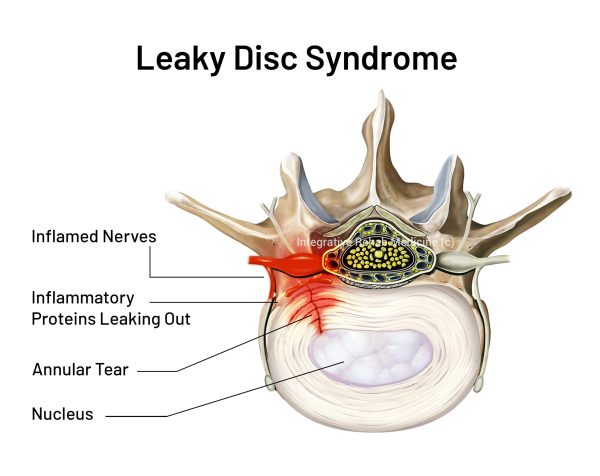Article at a Glance:
- Spinal injuries can disrupt the collagen fibers in the annulus, leading to annular tears and disc degeneration.
- Injured and painful spinal discs contain elevated inflammatory cytokines, which drive discogenic pain and accelerate degeneration.
- Leaky Disc Syndrome occurs when annular tears allow inflammatory proteins to leak out, triggering chronic pain and inflammation.
- Annular tears also permit the ingrowth of pain-sensing nerves, increasing disc hypersensitivity.
- Fibrin sealant has been shown to seal annular tears and promote regeneration of both the annulus and nucleus.
- The Discseel Procedure uses fibrin sealant to repair and heal spinal discs, offering long-term relief from chronic back pain and radiculitis.

The Spinal Discs
Spinal discs are rubbery, shock-absorbing structures that allow for spinal flexibility. Each disc has a tough outer layer, the annulus fibrosus, composed of 15-25 rings of collagen fibers, and a soft, gel-like center known as the nucleus pulposus. Excessive flexion and rotation loads can weaken the annulus, leading to annular tears, disc bulges, and disc degeneration (1).
The Role of Inflammation in Discogenic Pain
Injured and degenerated discs in patients with discogenic pain exhibit increased levels of inflammatory cytokines (TNF-alpha, IL-6, IL-8) compared to non-painful discs. These pro-inflammatory molecules contribute to further disc breakdown and chronic pain. Annular tears allow these cytokines to leak out, triggering an inflammatory immune response (2, 3, 5). Everyday movements—such as bending, twisting, and prolonged sitting—exacerbate this leakage, leading to irritation of nearby nerves and structures (4). This inflammation can result in chronic back pain, radiculitis, and recurrent episodes of the “back going out.”
Nerve Ingrowth and Disc Hypersensitivity
Annular tears also enable pain-sensing nerves to grow deep into the discs. The inflammatory cytokines increase nerve density within the injured disc, further heightening pain sensitivity. These nerves, in turn, release neuroinflammatory neurotransmitters that accelerate disc degeneration.
Schedule Your Consult with a Back Pain Specialist
Leaky Discs on Imaging: The Limitations of MRI
Annular tears are often missed on MRI, making diagnosis challenging. A 2015 study examined 108 patients with discogenic back pain using annulograms, where contrast dye was injected into four lumbar discs under fluoroscopy. On average, three discs per patient showed contrast leakage, confirming annular tears and leaky discs.
Following the annulogram, these patients received fibrin sealant injections into the affected discs. When retested 30 minutes later, the contrast no longer leaked, demonstrating that the fibrin had successfully sealed the annular tears (7).
Fibrin Sealant: A Non-Surgical Solution for Leaky Discs
A 2011 Spine study demonstrated fibrin’s effectiveness in sealing annular tears and promoting natural disc healing. Researchers induced disc injuries in 31 pigs, treating one disc with fibrin while leaving the other untreated for comparison. Over 12 weeks, the fibrin-treated discs showed (6):
- Reduced inflammation
- Stronger healing response
- Restored disc stiffness
- Increased pressure tolerance, preventing cytokine leakage
Additionally, fibrin has been shown to coat and seal off unmyelinated pain fibers, reducing disc hypersensitivity and chronic pain (8).
The Discseel Procedure: A Breakthrough in Disc Regeneration
Currently, Discseel is the only non-surgical treatment that uses fibrin sealant to seal annular tears with and promote disc healing . It offers a minimally invasive alternative to spinal fusion or disc replacement surgery, preserving spinal mobility and function while providing long-term pain relief.
For patients suffering from discogenic pain, radiculitis, or recurrent back instability, fibrin sealant may be the key to healing the disc at its source, restoring function, and avoiding surgery.
Be on the lookout for my next blog post, I will cover a groundbreaking study of 827 patients with chronic back pain who were treated with intradiscal Fibrin sealant and followed for 3 years.
References:
- Latridis, James C., and Iolo ap Gwynn. “Mechanisms for mechanical damage in the intervertebral disc annulus fibrosus.” Journal of biomechanics 37.8 (2004): 1165-1175.
- Burke, J. G., et al. “Intervertebral discs which cause low back pain secrete high levels of proinflammatory mediators.” The Journal of Bone & Joint Surgery British Volume 84.2 (2002): 196-201.
- Sainoh, Takeshi, et al. “Correlation among inflammatory cytokine expression levels, degree of disk degeneration, and predominant clinical symptoms in patients with degenerated intervertebral discs.” Asian Spine Journal 11.3 (2017): 472
- Lyu, Feng-Juan, et al. “Painful intervertebral disc degeneration and inflammation: from laboratory evidence to clinical interventions.” Bone research 9.1 (2021): 7.
- Sharma, A., T. Pilgram, and F. J. Wippold. “Association between annular tears and disk degeneration: a longitudinal study.” American journal of neuroradiology 30.3 (2009): 500-506.
- Buser, Zorica, et al. “Biological and biomechanical effects of fibrin injection into porcine intervertebral discs.” Spine 36.18 (2011): E1201-E1209.
- Pauza, Kevin, Carrie Wright, and Adam Fairbourn. “Treatment of annular disc tears and “leaky disc syndrome” with fibrin sealant.” Techniques in Regional Anesthesia and Pain Management 19.1-2 (2015): 45-49.
- Weisshaar, Christine L., et al. “The potential for salmon fibrin and thrombin to mitigate pain subsequent to cervical nerve root injury.” Biomaterials 32 (2011): 9738e9746
